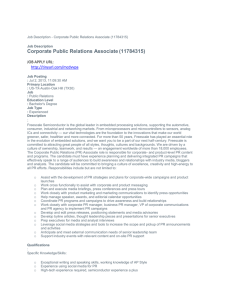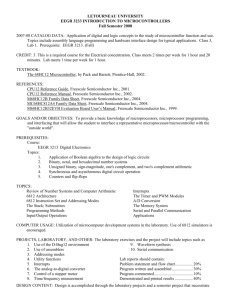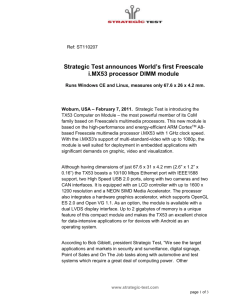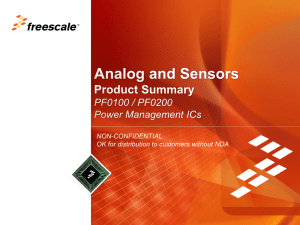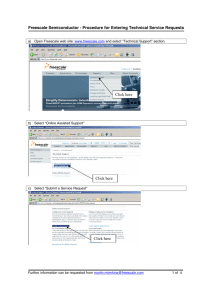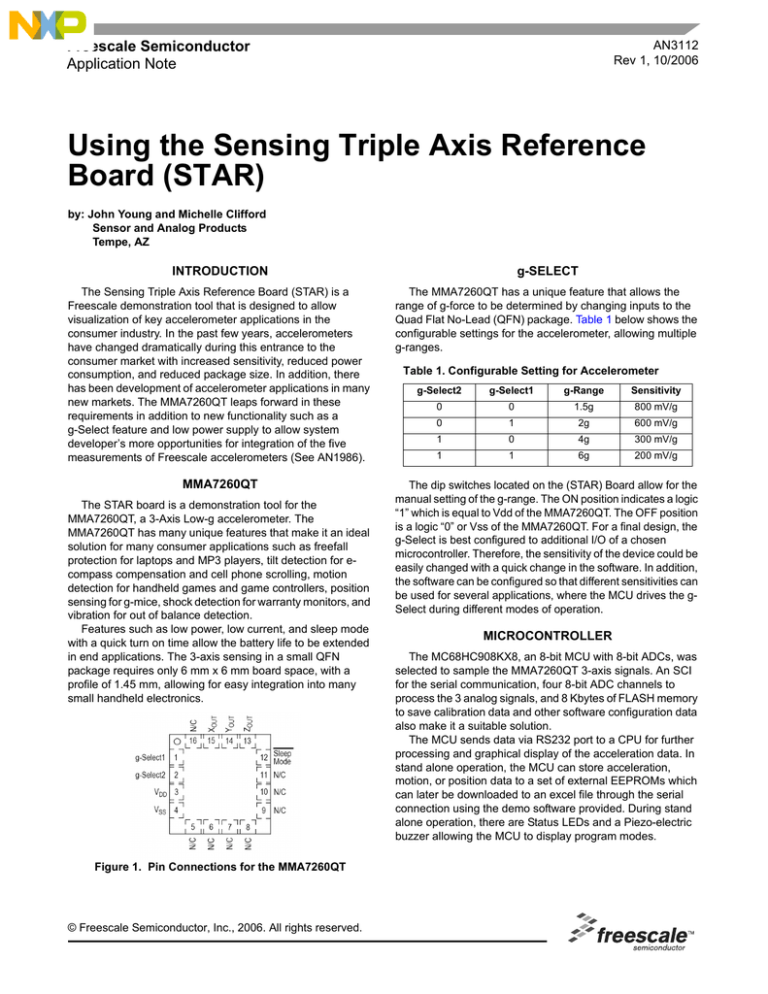
Freescale Semiconductor
Application Note
AN3112
Rev 1, 10/2006
Using the Sensing Triple Axis Reference
Board (STAR)
by: John Young and Michelle Clifford
Sensor and Analog Products
Tempe, AZ
INTRODUCTION
g-SELECT
The Sensing Triple Axis Reference Board (STAR) is a
Freescale demonstration tool that is designed to allow
visualization of key accelerometer applications in the
consumer industry. In the past few years, accelerometers
have changed dramatically during this entrance to the
consumer market with increased sensitivity, reduced power
consumption, and reduced package size. In addition, there
has been development of accelerometer applications in many
new markets. The MMA7260QT leaps forward in these
requirements in addition to new functionality such as a
g-Select feature and low power supply to allow system
developer’s more opportunities for integration of the five
measurements of Freescale accelerometers (See AN1986).
The MMA7260QT has a unique feature that allows the
range of g-force to be determined by changing inputs to the
Quad Flat No-Lead (QFN) package. Table 1 below shows the
configurable settings for the accelerometer, allowing multiple
g-ranges.
MMA7260QT
The dip switches located on the (STAR) Board allow for the
manual setting of the g-range. The ON position indicates a logic
“1” which is equal to Vdd of the MMA7260QT. The OFF position
is a logic “0” or Vss of the MMA7260QT. For a final design, the
g-Select is best configured to additional I/O of a chosen
microcontroller. Therefore, the sensitivity of the device could be
easily changed with a quick change in the software. In addition,
the software can be configured so that different sensitivities can
be used for several applications, where the MCU drives the gSelect during different modes of operation.
The STAR board is a demonstration tool for the
MMA7260QT, a 3-Axis Low-g accelerometer. The
MMA7260QT has many unique features that make it an ideal
solution for many consumer applications such as freefall
protection for laptops and MP3 players, tilt detection for ecompass compensation and cell phone scrolling, motion
detection for handheld games and game controllers, position
sensing for g-mice, shock detection for warranty monitors, and
vibration for out of balance detection.
Features such as low power, low current, and sleep mode
with a quick turn on time allow the battery life to be extended
in end applications. The 3-axis sensing in a small QFN
package requires only 6 mm x 6 mm board space, with a
profile of 1.45 mm, allowing for easy integration into many
small handheld electronics.
Figure 1. Pin Connections for the MMA7260QT
© Freescale Semiconductor, Inc., 2006. All rights reserved.
Table 1. Configurable Setting for Accelerometer
g-Select2
g-Select1
g-Range
Sensitivity
0
0
1.5g
800 mV/g
0
1
2g
600 mV/g
1
0
4g
300 mV/g
1
1
6g
200 mV/g
MICROCONTROLLER
The MC68HC908KX8, an 8-bit MCU with 8-bit ADCs, was
selected to sample the MMA7260QT 3-axis signals. An SCI
for the serial communication, four 8-bit ADC channels to
process the 3 analog signals, and 8 Kbytes of FLASH memory
to save calibration data and other software configuration data
also make it a suitable solution.
The MCU sends data via RS232 port to a CPU for further
processing and graphical display of the acceleration data. In
stand alone operation, the MCU can store acceleration,
motion, or position data to a set of external EEPROMs which
can later be downloaded to an excel file through the serial
connection using the demo software provided. During stand
alone operation, there are Status LEDs and a Piezo-electric
buzzer allowing the MCU to display program modes.
More information regarding the MCU can be found in the
MC68HC908KX8, MC68HC908KX2 Technical Datasheet
(Freescale document number MC68HC908KX8/D).
REFERENCE BOARD
accelerometer applications. Many design considerations were
taken in effect to have a small and versatile tool (board size is
1.850" x 1.50").
Table 2 provides a brief description of the components on
the STAR board and Figure 2 shows the location on the board.
The goal of the Mini-TRIAX was to provide a small board
with the capability to demonstrate and evaluate many
Table 2. Components on the Mini-TRIAX Board
Component
Component Function
MMA7260QT
3 axis Accelerometer part to give vibration and inertial readings to the board
MC68HC908KX8
8-Bit processor used on the board. It is featured in a dip socket rather than SMT so it can be removed
by a user for reprogramming for final solution designing.
LM317-L
Adjustable Voltage regulator. This part allows for the regulation of power to all the components on the
board. 3.6 V
LM2765M6
Charge pump. This allows the use of a small 3 V battery to provide power at a higher voltage to the
necessary level for the other components. With this, a standard 3V, 2/3A battery can easily be
purchased. It keeps the size small rather than using a large 9V battery & holder.
2/3A battery Holder
The power of the board is supplied by a 3 V 2/3 A or 123 battery. It is commercially available at any
consumer battery stand. This is the holder.
DB9 Serial Connector
The Mini-TRIAX communicates using a RS232 port, and this is the connector used for the cable.
MAX3316CAE
RS232 Chipset. This part allows the interface between the MCU and the standard RS232
communications port.
CTX690CT-ND
This is the external canned clock oscillator that allows the MCU to communicate with the RS232 port.
This clock is set for 14.7456 MHz
25LC640
This is one of two EEPROMs. They are used via SCI to store accelerometer values at 200 times a
second to memory.
Dip Switch
The STAR contains a set of 2 dip switches that allow the user to use the function defined as ‘g-select’
on the MMA7260QT accelerometer. This enables the user to define the g-force range, from a 1.5 g
device to a 2 g, 4 g, and 6 g device with two simple buttons.
Momentary switch
This enables the MCU to detect inputs to the STAR from the user during standalone mode, when the
board is not connected via RS232.
Buzzer & LEDs
These provide status/outputs for the STAR. It notifies the user if the board is on, if a certain condition is
satisfied, etc.
AN3112
2
Sensors
Freescale Semiconductor
Main Switch
Charge Pump
HC908KX8 MCU
MMA7260Q
MMA7260QAccelerometer
Accelerometer
Oscillator
Power LED
Status/Alarm LED
g-Select
g-SelectDipswitch
Dip switch
Adj. Voltage Regulator
RS232 Chipset
123 or 2/3A
3V Battery holder
DB9 RS232 Connector
Momentary
Pushbutton
Figure 2. Location of Components on Board
AN3112
Sensors
Freescale Semiconductor
3
VOLTAGE/POWER
A 2/3 A battery was chosen as a power supply with its ability
to supply 1400 mAH for the STAR. It was also a design
consideration to reduce the size of the demonstration board.
The 2/3 A battery is available at any commercial battery stand.
The other options were two AA batteries or a 9 V battery,
significantly larger in size when coupled with battery holders.
As can be seen in Figure 2, a number of the components are
driven at a 3.6 V supply. The MMA7260QT is optimal at 3.3 V
so a slightly higher voltage was used to compensate for any
small drop in voltage. The RS232 chipset was driven directly
from the 3 V source due to the logic level thresholds of that
particular device.
The 3.6 V supply is obtained from the 3 V battery by the use
of a charge pump, the LM2765M6. This allows the doubling of
voltage to 6 V. This is regulated back down to 3.6 V via the
adjustable regulator LM317-L and supplied to the other ICs.
Figure 3. Schematic of Board
SOFTWARE
A software program was developed to provide an interface as
well as a development system. The software can be used for
displaying the 8-bit ADC values sent through the RS232
connection, or utilized for analyzing accelerometer data to
demonstrate end applications. The software is sorted by various
modules that showcase these possible end-applications for the
MMA7260QT. This allows for developmental ideas for the
MMA7260QT as a user can sample possible final products with
a single reference/development tool. Some software modules
such as free fall and battery saver can be initiated without the use
of the PC connection, activated by a push button. The software
available for the STAR board can be found on the Freescale Web
site.
MODES OF OPERATION
The STAR board has three modes of operation - sending
data to the PC for analysis or display, saving data to external
memory (2 EEPROMs), or running a stand alone module. The
stand alone modules contain demonstration tools such as
freefall, battery saver, or shock alarm. The operation mode
can be selected via the STAR’s push button or by selecting a
stand alone module on the PC software. In the push button
operation mode, a user can push the STAR’s tactile switch to
select the most recent stand alone module. If the user
depresses the same button for 20 seconds, it will cause the
STAR to run the freefall stand alone module.
SUMMARY
The MMA7260QT has many unique features such as low
power, low current, a quick turn on time, and 3-axis sensing
with g-select all in a small QFN package. The STAR enables
the user to quickly see many capabilities of the device along
with application ideas to pursue. In addition, with data
download capability, the STAR provides a quick way to
prototype a software solution to gain a better understanding
for the capability of the device.
AN3112
4
Sensors
Freescale Semiconductor
APPENDIX A
Figure 4. Component Layer of STAR Board
Figure 5. Component Silkscreen
Figure 6. All Layers
AN3112
Sensors
Freescale Semiconductor
5
How to Reach Us:
Home Page:
www.freescale.com
E-mail:
support@freescale.com
USA/Europe or Locations Not Listed:
Freescale Semiconductor
Technical Information Center, CH370
1300 N. Alma School Road
Chandler, Arizona 85224
+1-800-521-6274 or +1-480-768-2130
support@freescale.com
Europe, Middle East, and Africa:
Freescale Halbleiter Deutschland GmbH
Technical Information Center
Schatzbogen 7
81829 Muenchen, Germany
+44 1296 380 456 (English)
+46 8 52200080 (English)
+49 89 92103 559 (German)
+33 1 69 35 48 48 (French)
support@freescale.com
Japan:
Freescale Semiconductor Japan Ltd.
Headquarters
ARCO Tower 15F
1-8-1, Shimo-Meguro, Meguro-ku,
Tokyo 153-0064
Japan
0120 191014 or +81 3 5437 9125
support.japan@freescale.com
Asia/Pacific:
Freescale Semiconductor Hong Kong Ltd.
Technical Information Center
2 Dai King Street
Tai Po Industrial Estate
Tai Po, N.T., Hong Kong
+800 2666 8080
support.asia@freescale.com
For Literature Requests Only:
Freescale Semiconductor Literature Distribution Center
P.O. Box 5405
Denver, Colorado 80217
1-800-441-2447 or 303-675-2140
Fax: 303-675-2150
LDCForFreescaleSemiconductor@hibbertgroup.com
AN3112
Rev 1
10/2006
Information in this document is provided solely to enable system and software
implementers to use Freescale Semiconductor products. There are no express or
implied copyright licenses granted hereunder to design or fabricate any integrated
circuits or integrated circuits based on the information in this document.
Freescale Semiconductor reserves the right to make changes without further notice to
any products herein. Freescale Semiconductor makes no warranty, representation or
guarantee regarding the suitability of its products for any particular purpose, nor does
Freescale Semiconductor assume any liability arising out of the application or use of any
product or circuit, and specifically disclaims any and all liability, including without
limitation consequential or incidental damages. “Typical” parameters that may be
provided in Freescale Semiconductor data sheets and/or specifications can and do vary
in different applications and actual performance may vary over time. All operating
parameters, including “Typicals”, must be validated for each customer application by
customer’s technical experts. Freescale Semiconductor does not convey any license
under its patent rights nor the rights of others. Freescale Semiconductor products are
not designed, intended, or authorized for use as components in systems intended for
surgical implant into the body, or other applications intended to support or sustain life,
or for any other application in which the failure of the Freescale Semiconductor product
could create a situation where personal injury or death may occur. Should Buyer
purchase or use Freescale Semiconductor products for any such unintended or
unauthorized application, Buyer shall indemnify and hold Freescale Semiconductor and
its officers, employees, subsidiaries, affiliates, and distributors harmless against all
claims, costs, damages, and expenses, and reasonable attorney fees arising out of,
directly or indirectly, any claim of personal injury or death associated with such
unintended or unauthorized use, even if such claim alleges that Freescale
Semiconductor was negligent regarding the design or manufacture of the part.
Freescale™ and the Freescale logo are trademarks of Freescale Semiconductor, Inc.
All other product or service names are the property of their respective owners.
© Freescale Semiconductor, Inc. 2006. All rights reserved.


